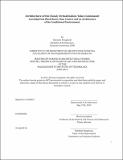| dc.contributor.advisor | Mark Jarzombek. | en_US |
| dc.contributor.author | Furgiuele, Antonio | en_US |
| dc.contributor.other | Massachusetts Institute of Technology. Department of Architecture. | en_US |
| dc.date.accessioned | 2013-10-24T18:12:18Z | |
| dc.date.available | 2013-10-24T18:12:18Z | |
| dc.date.copyright | 2013 | en_US |
| dc.date.issued | 2013 | en_US |
| dc.identifier.uri | http://hdl.handle.net/1721.1/81746 | |
| dc.description | Thesis (S.M. in History, Theory and Criticism of Art and Architecture)--Massachusetts Institute of Technology, Dept. of Architecture, 2013. | en_US |
| dc.description | This electronic version was submitted by the student author. The certified thesis is available in the Institute Archives and Special Collections. | en_US |
| dc.description | Cataloged from student-submitted PDF version of thesis. | en_US |
| dc.description | Includes bibliographical references (p. 127-128). | en_US |
| dc.description.abstract | A single manageable architecture of the Cloud has been one of the most important social and technical changes of the 21st century. Cloud computing, our newest public utility is an attempt to confront and control cultural risk, it has rendered the environment of our exchanges calculable, manageable, seemingly predictable, and most importantly as a new form of capital. Cloud computing in its most basic terms is the system of virtualization of data storage and program access into an instantaneous service utility. The transformation of computing into a service industry is one of the key changes of the Information Age, and its logic is tied to the highly guarded mechanisms of a black box, an architecture machine, or more commonly known as the data center. In 2008, on a day with without the usual fanfare or barrage of academic manifestoes, grand claims of paradigm shifts, virtualization quietly took command. A seemingly simple moment where a cloud, the Cloud, emerged as a new form of managerial space that tied a large system of users to the hidden mechanisms of large scaled factories of information, a network of data centers. The project positions the Cloud and the data center into the architectural discourse, both historically and materially, through an analysis of its relationship to an emergent digital sublime and how it is managed, controlled and propelled through the obscure typologies of its architecture and images. The study of the Cloud and the data center through the notion of the sublime, and the organizational structures of typology we can more critically assess architecture's relationship to this new phase of the Information Age. | en_US |
| dc.description.statementofresponsibility | by Antonio Furgiuele. | en_US |
| dc.format.extent | 128 p. | en_US |
| dc.language.iso | eng | en_US |
| dc.publisher | Massachusetts Institute of Technology | en_US |
| dc.rights | M.I.T. theses are protected by
copyright. They may be viewed from this source for any purpose, but
reproduction or distribution in any format is prohibited without written
permission. See provided URL for inquiries about permission. | en_US |
| dc.rights.uri | http://dspace.mit.edu/handle/1721.1/7582 | en_US |
| dc.subject | Architecture. | en_US |
| dc.title | Architecture of the cloud, virtualization takes command : learning from black boxes, data centers and an architecture of the conditioned environment | en_US |
| dc.type | Thesis | en_US |
| dc.description.degree | S.M.in History, Theory and Criticism of Art and Architecture | en_US |
| dc.contributor.department | Massachusetts Institute of Technology. Department of Architecture | |
| dc.identifier.oclc | 859800286 | en_US |
